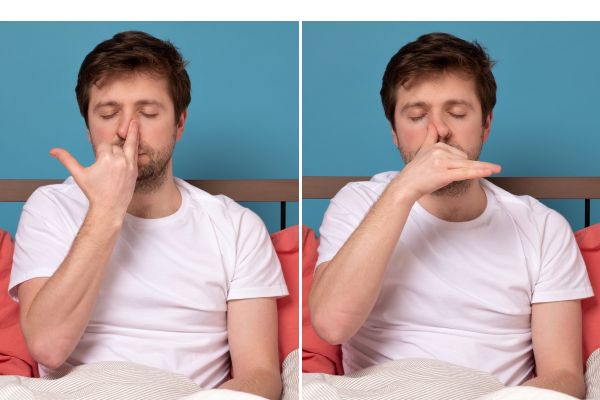Breathwork Unleashed: Discover the Transformative Benefits of Breathwork Techniques for Beginners
Welcome to the fascinating world of breathwork! In a fast-paced and demanding world, taking a moment to focus on our breath can unlock a wealth of physical, mental, and emotional benefits. Whether you’re seeking to
- Relief stress or anxiety
- Increased energy
- Calm your body & mind
- Create a deeper connection with your inner self
Breathwork has the power to improve your mental health & physical well-being in minutes!
In this blog post, we will explore three types of breathwork techniques specifically tailored for beginners. You’ll learn how each technique works, why they are beneficial, and how to incorporate them into your daily routine. So, let’s dive in and discover the profound impact that conscious breathing can have on your life. Get ready to embark on a journey of self-discovery and inner peace as we explore the world of breathwork together.

BREATHWORK BENEFITS 3 Types of Breathwork for Beginners
BREATHWORK BENEFITS 3 Types of Breathwork for Beginners
What is Breathwork?
Breathwork refers to a set of techniques and practices that involve conscious control and manipulation of breathing patterns to achieve physical, mental, and emotional well-being.
It involves various breathing exercises and methods designed to enhance relaxation, reduce inflammation, decrease stress, increase energy levels, improve focus, and promote overall health. By paying attention to and consciously altering our breath, we can quickly and efficiently influence our body and mind, accessing a state of calm, clarity, and balance.

BREATHWORK BENEFITS 3 Types of Breathwork for Beginners
Why is Breathwork so Powerful?
Breathwork is so powerful because our breath is intimately connected to our autonomic nervous system, which regulates crucial bodily functions beyond our conscious control.
By consciously altering our breath, we can directly influence our physiological and psychological state.
Deep, intentional breathing activates the parasympathetic nervous system, triggering a relaxation response and reducing stress, increasing oxygenation and improves circulation. Breathwork also helps quiet the mind, bringing awareness to the present moment and promoting mindfulness. It’s simplicity and accessibility make it a potent tool for self-regulation and stress management improving overall physical and mental well-being.
3 Types of Breathwork for Beginners

BREATHWORK BENEFITS 3 Types of Breathwork for Beginners
(1) Diaphragmatic Breathing
DIAPHRAGMATIC BREATHING: This technique focuses on deepening and expanding the breath by engaging the diaphragm muscle.
Diaphragmatic breathing, also known as belly breathing or deep breathing, involves engaging the diaphragm muscle to take deep, slow breaths. This technique helps to increase the flow of oxygen throughout the body, relax the muscles, and activate the body’s natural relaxation response. Diaphragmatic breathing is particularly beneficial for reducing anxiety, improving lung function, and promoting a sense of calm.
To incorporate diaphragmatic breathing into your daily routine, find a comfortable position and place one hand on your abdomen. Breathe in deeply through your nose, allowing your abdomen to rise as you fill your lungs with air. Exhale slowly through your mouth, feeling your abdomen fall. Repeat this pattern for several minutes, focusing on the sensation of your breath and the gentle rise and fall of your abdomen.

BREATHWORK BENEFITS 3 Types of Breathwork for Beginners
(2) Box Breathing
BOX BREATHING: This technique involves equalizing the length of inhalation, holding the breath, exhalation, and holding again in a structured pattern.
Box breathing, also known as square breathing, is a powerful technique that helps regulate the autonomic nervous system, promoting a state of calm and reducing stress. By consciously controlling the breath, this technique can slow down the heart rate, lower blood pressure, and activate the relaxation response in the body.
Incorporating box breathing into your daily routine can bring a sense of mental clarity, improved focus, and enhanced emotional well-being. To practice box breathing, find a quiet space and follow this simple pattern: inhale for a count of four, hold the breath for a count of four, exhale for a count of four, and hold the breath again for a count of four. Repeat this cycle several times, gradually increasing the duration as you become more comfortable.
TOP TIP: As you get more confident in box breathing try to increase the count from 4-4-4-4 to 6-6-6-6 or more…

BREATHWORK BENEFITS 3 types of breathwork for beginners
(3) Alternate Nostril Breathing
Alternate Nostril Breathing (Nadi Shodhana): This technique aims to balance the flow of energy in the body by alternating the breath between the left and right nostrils.
Alternate Nostril Breathing: Alternate nostril breathing is a powerful breathwork technique that balances the flow of energy in the body and calms the mind. It is believed to harmonize the left and right hemispheres of the brain, enhancing cognitive function and promoting mental clarity. This technique is particularly effective for reducing stress, increasing focus, and finding inner balance.
To practice alternate nostril breathing, find a comfortable seated position and use your right hand to close your right nostril with your thumb. Inhale deeply through your left nostril, then close it with your ring finger. Release your thumb and exhale through your right nostril. Inhale through the right nostril, close it, and exhale through the left. Repeat this cycle for several rounds, focusing on the rhythm of your breath and the sensation of air passing through each nostril.

BREATHWORK BENEFITS 3 types of breathwork for beginners
What are the Dangers of Breathwork?
These 3 types of breathwork for beginners are generally regarded as safe. However, it’s important to note that everyone’s body is unique, and there may be rare cases where individuals experience discomfort or adverse reactions. As a general guideline, it’s always advisable to listen to your body, start slowly, and gradually increase the duration and intensity of your breathwork practices.
Alternate Nostril Breathing, some people may find it challenging to breathe through one nostril or experience mild nasal discomfort. If you have any nasal conditions or congestion, it’s advisable to proceed with caution or consult a healthcare professional.
Diaphragmatic Breathing and Box Breathing are natural and gentle practices, but if you feel lightheaded or dizzy during these exercises, it’s recommended to take a break and resume normal breathing.
Breathwork Benefits for Inflammation

BREATHWORK BENEFITS 3 types of breathwork for beginners
How does Breathwork Reduce Inflammation in the body?
Breathwork has been shown to have potential benefits in reducing inflammation in the body through various mechanisms:
Stress Reduction: Chronic stress can contribute to inflammation in the body. Breathwork techniques, such as deep diaphragmatic breathing or slow, controlled breathing, activate the parasympathetic nervous system, promoting relaxation and reducing the release of stress hormones like cortisol. By reducing stress levels, breathwork indirectly helps lower inflammation.
Oxygenation: Breathwork practices involve conscious and intentional deep breathing, which increases oxygen intake. Oxygen plays a crucial role in cellular function and metabolism. Improved oxygenation through breathwork can support the body’s healing processes and reduce oxidative stress, which can contribute to inflammation.
Enhanced Blood Flow: Certain breathwork techniques, such as rhythmic breathing or alternate nostril breathing, can improve blood circulation. Increased blood flow delivers oxygen and nutrients to tissues more efficiently and aids in the removal of waste products. This improved circulation can help reduce inflammation by supporting tissue repair and reducing localized inflammation.
Relaxation Response: Breathwork activates the relaxation response in the body, which involves the release of neurotransmitters and hormones that promote a sense of calm. This response helps counteract the effects of the sympathetic nervous system, which is associated with inflammation. By inducing relaxation, breathwork can help modulate the body’s inflammatory response.
While breathwork can have positive effects on inflammation, it’s important to note that it may not be a standalone treatment for chronic inflammatory conditions. It can be used as a complementary practice alongside herbal remedies, medical interventions and a healthy lifestyle to support overall well-being and potentially contribute to reducing inflammation in the body.
Buy Anti-Inflammatory Herbs | Buy Anti-Inflammatory Supplements
-
Product on saleAnti-Inflammatory Herbs – powder sample packOriginal price was: $63.00.$45.95Current price is: $45.95.
-
Product on saleBEST Anti-Inflammatory Supplements – capsulesOriginal price was: $85.00.$68.95Current price is: $68.95. — or subscribe and save up to 10%
BREATHWORK BENEFITS 3 Types of Breathwork for Beginners

BREATHWORK BENEFITS 3 Types of Breathwork for Beginners
Is Breathwork Scientifically Proven?
Breathwork has gained attention in both scientific research and traditional practices, and several studies have explored its effects on various aspects of physical and mental well-being.
Here are a few examples of scientific studies that support the effectiveness of breathwork techniques:
Stress Reduction: A study published in the Journal of Alternative and Complementary Medicine (2017) found that slow-paced breathing exercises significantly reduced perceived stress levels and improved autonomic function in healthy individuals.
Blood Pressure Management: A systematic review published in the journal Complementary Therapies in Medicine (2016) analysed multiple studies and concluded that specific breathwork techniques, such as slow breathing and alternate nostril breathing, were effective in lowering blood pressure and improving cardiovascular health.
Pain Management: A study published in Pain Medicine (2017) investigated the effects of breath-focused meditation on pain perception in chronic pain patients. The results indicated that participants who practiced breath-focused meditation experienced reduced pain intensity and improved pain tolerance compared to a control group.
Happy Customers
Comments from Happy Customers about our range of Delicious & Natural Anti-Inflammatory Herbs

Conclusion
BREATHWORK BENEFITS 3 Types of Breathwork for Beginners
The transformative power of breathwork is undeniable. Whether you choose the calming rhythm of diaphragmatic breathing or the deep introspection of alternate nostril breathing, each technique offers unique benefits for beginners. By incorporating breathwork into your daily routine, you can unlock a world of physical, mental, and emotional well-being.
Take a deep breath, embrace the power within, and embark on a journey of self-discovery. Empower yourself with the gift of breath and witness the incredible impact it can have on your overall health and vitality. Start your breathwork practice today and open the door to a harmonious and balanced life.
BREATHWORK BENEFITS 3 Types of Breathwork for Beginners






